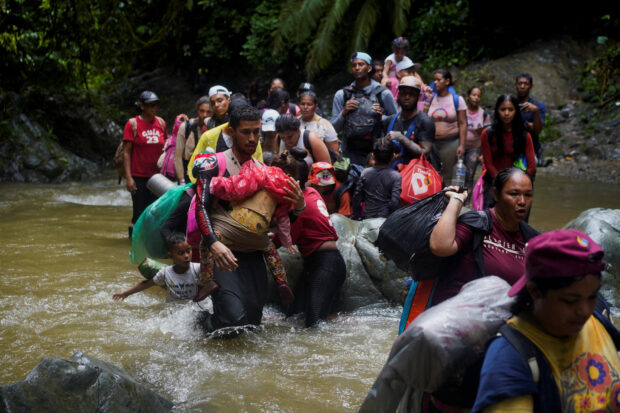In the midst of the Panamanian jungle, Franca Ramirez, a Venezuelan migrant, found himself facing a rapidly rising river and the need to seek higher ground. In that moment, he noticed a group of young men capturing photos of the landscape. Surprised by their presence, Ramirez, a former police officer who fled Venezuela due to imprisonment and torture, questioned them about their purpose. To his amazement, they revealed that they were not migrants like him, but rather content creators and tourists exploring the jungle.
This encounter represented a rare convergence of two distinct worlds in one of the wildest places on Earth. For years, the Darien Gap in Panama has attracted adventurous individuals, earning its reputation as the missing segment, around 60 miles long, on the Pan-American highway that stretches from Alaska to Argentina. These intrepid travelers would venture into the impenetrable forest, navigating through guerrillas and bandits, seeking rare orchids or the great green macaw, and relishing in the thrill of reaching the end of the road.
As adventure tourism gained popularity worldwide, with activities ranging from climbing Mount Everest to exploring the wreckage of the Titanic, tour agencies also recognized the appeal of organizing excursions to the remote Darien jungle. Rick Morales, an experienced Panamanian tour guide, described the allure of the jungle, emphasizing its power and ability to humble those who enter.
However, in recent years, the jungle has also become a site of humanitarian crisis. Hundreds of thousands of migrants from various parts of the world, including Afghanistan and Africa, traverse this treacherous terrain in their pursuit of reaching the United States. Due to visa restrictions in nearby countries, approximately 250,000 people journeyed through this lawless region last year alone. Tragically, at least 137 migrants, including 13 minors, died or went missing, according to the International Organization for Migration (IOM).
The Darien poses multiple challenges, including a lack of infrastructure and the presence of criminal groups that control the migrant routes. The IOM notes that the actual number of migrant deaths and disappearances is likely much higher than officially reported. Given the vast distance between migrants and tourists, face-to-face interactions are rare. Migrant routes typically follow the Darien’s northern coast along the Caribbean Sea, while tourism activities concentrate closer to the Pacific Ocean. The advertising for tourist trips conveniently omits mention of the ongoing humanitarian crisis.
While adventurous tourists may pay hundreds or even thousands of dollars for guided excursions equipped with medical care, satellite phones, proper equipment, and a cook, migrants dependent on smugglers often receive far less for their money. Migrants face significant risks and have to fend for themselves. Kisbel Garcia, a Venezuelan migrant, paid over $4,000 to a guide who ultimately abandoned her, her children, and her mother-in-law in the jungle. They spent six days navigating through mountains, running out of food, and relying on crude markers left by prior migrants to find their way.
The rise of adventure tourism worldwide, fueled by social media and the desire to explore remote and inaccessible places, has attracted criticism in the Darien. Humanitarian aid groups argue that marketing trips as survival challenges is tasteless, diverting attention from the suffering endured by migrants. The ethical responsibility of engaging in such tourism encounters prompts important questions. Lorri Krebs, an expert on tourism and sustainability, emphasizes the need for standards and ethical considerations in tourism endeavors.
Panama’s government, on one hand, aims to promote the Darien National Park as a leading eco-tourism destination in Central America. The park’s UNESCO World Heritage status, bestowed in 1981, further adds to its appeal for naturalists, bird watchers, and those interested in indigenous communities. Even some migrants themselves recognize the paradoxical allure of the jungle, finding delight in the scenery while their hearts ache from the hardships they endure.
On the other hand, humanitarian aid groups, including Doctors Without Borders (MSF), condemn adventure tourism in the Darien, emphasizing that this region is a humanitarian crisis zone rather than a vacation destination. The intersection of these worlds sparks a discussion about ethical responsibility and the need for moral considerations in tourism activities.
As Panama faces pressure from the U.S. government to curb migrant crossings, the numbers of migrants in the Darien continue to rise. The U.S. State Department advises against entering the jungle due to the presence of criminals and drug traffickers, as well as limited emergency services. Tourists in other parts of the world face similar ethical dilemmas, sunbathing or hiking in areas where others risk their lives. Rick Morales, the tour guide, shares his personal conflict, acknowledging that he couldn’t enjoy shelter and food while knowing that hungry families were suffering just meters away.
As tourists grapple with these questions, the need for ethical tourism standards becomes increasingly important. The migration crisis demands acknowledgment and empathy from those who venture into these regions, as irresponsibly exploiting these areas for personal enjoyment disregards the suffering experienced by migrants.
Denial of responsibility! VigourTimes is an automatic aggregator of Global media. In each content, the hyperlink to the primary source is specified. All trademarks belong to their rightful owners, and all materials to their authors. For any complaint, please reach us at – [email protected]. We will take necessary action within 24 hours.


